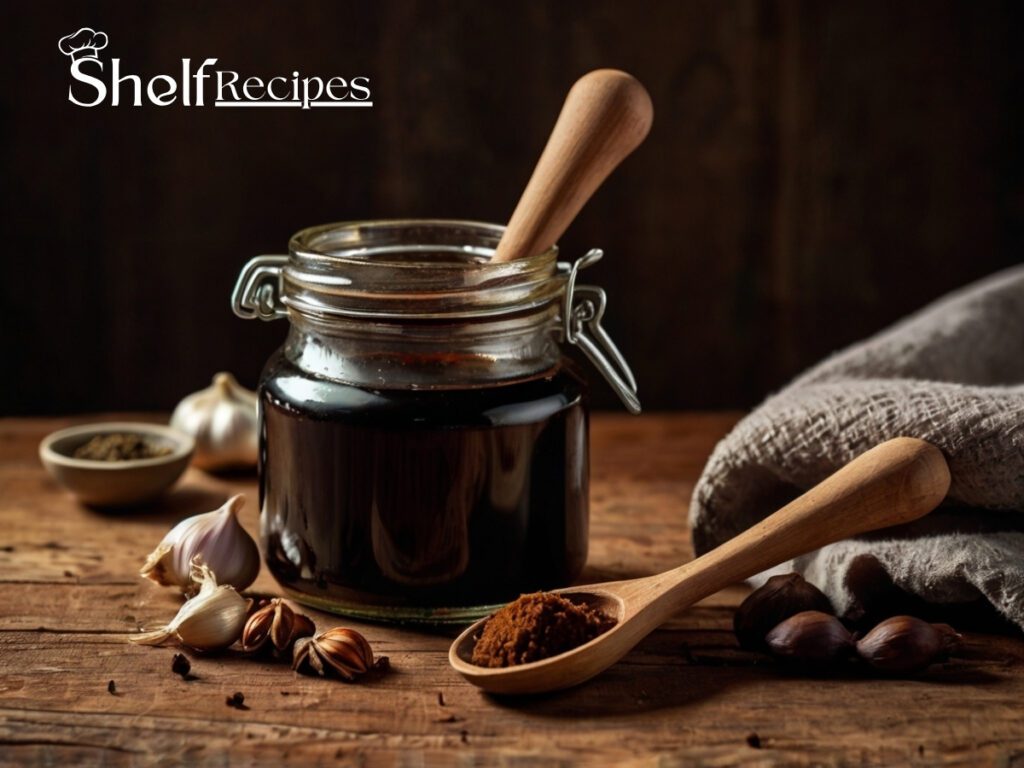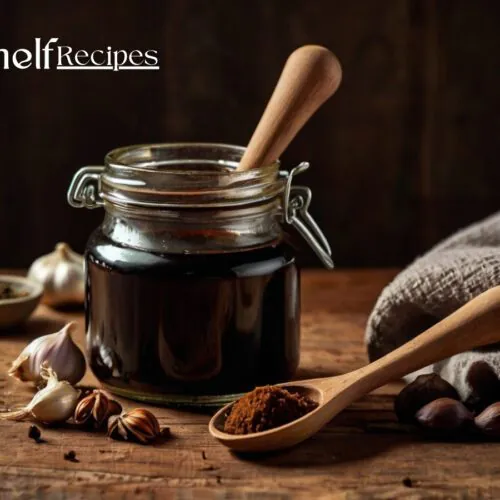
Making your own Worcestershire sauce at home is fun. It also lets you adjust the flavors to your taste. Making Worcestershire sauce from scratch is a rewarding task. Whether you need it for green bean casserole or just want to know what’s in it, you’ll enjoy the process. In this article, we will look at the key ingredients for Worcestershire sauce. We will also show you a simple recipe to make your own.
Understanding Worcestershire Sauce
Worcestershire sauce is a fermented liquid condiment originating from England. It’s known for its complex flavor profile, including tangy, savory, and slightly sweet notes. The sauce is commonly used to enhance the taste of meats, stews, and soups.
The History of it
The origins of Worcestershire sauce trace back to the early 19th century in the town of Worcester, England. Legend has it that two chemists, John Lea and William Perrins, concocted the sauce from a recipe brought from India. At first, it was considered inedible. After fermenting in barrels, the flavors changed into the iconic taste we know today. This accidental discovery has since become a staple in kitchens worldwide.
The Fermentation Process
Fermentation is key to developing Worcestershire sauce’s signature depth of flavor. This process involves breaking down sugars in ingredients through the action of bacteria and yeast. During fermentation, the sauce becomes more complex. It balances the acidity of vinegar, the sweetness of molasses, and the umami from anchovies. Patience is crucial, as the fermentation process can take weeks to achieve the desired richness.
Culinary Uses of Worcestershire Sauce
Beyond its traditional uses in savory dishes, Worcestershire sauce has found its way into creative culinary applications. Chefs use it as a secret ingredient in salad dressings and barbecue sauces. They also add it to surprising desserts for extra flavor. Its versatility makes it a favorite among home cooks and professional chefs alike, offering endless possibilities for experimentation.
Key Ingredients
The traditional Worcestershire sauce ingredients include:
- Vinegar: Adds acidity and tanginess.
- Molasses: Contributes to the sweetness and depth of flavor.
- Soy Sauce: Provides umami and saltiness.
- Anchovies: Offer a savory, umami-rich taste.
- Garlic and Onion: Enhance the overall flavor complexity.
- Tamarind: Adds a unique sour note.
- Spices: Typically include cloves, chili pepper, and sometimes curry powder.
The Role of Vinegar
Vinegar is a fundamental component of Worcestershire sauce, delivering the essential tanginess that balances other flavors. Apple cider vinegar is often liked for its mild sweetness. However, you can use other types, like malt or white vinegar, for different flavors. The acidity not only enhances taste but also acts as a preservative, extending the sauce’s shelf life.
For more information, check this article from The Nutrition Source.
Molasses: Sweetness and Depth
Molasses brings a rich sweetness that complements the sauce’s savory elements. Derived from sugarcane or sugar beet processing, it adds a deep, caramel-like note. The type of molasses you use, light or dark, can change the sauce’s flavor. This lets you customize it to your taste.
Umami from Anchovies and Soy Sauce
Anchovies and soy sauce are the umami powerhouses in Worcestershire sauce. Anchovies, rich in glutamates, impart a savory depth that rounds out the sauce’s complexity. Soy sauce, with its fermented soybeans, adds both umami and a touch of saltiness. Together, they create a harmonious blend that defines the sauce’s character.
Benefits of Making Worcestershire Sauce at Home
Crafting Worcestershire sauce at home offers several advantages:
Customizable Flavor
By adjusting the Worcestershire sauce ingredients, you can create a condiment that perfectly suits your taste preferences. Prefer it spicier? Add more chili pepper. Want it sweeter? Increase the molasses.
Control Over Ingredients
Homemade Worcestershire sauce lets you use good ingredients. You can also avoid preservatives and additives in store-bought sauces. This control ensures that every component is natural and free from unnecessary chemicals, providing a healthier alternative.
Freshness
Freshly made Worcestershire sauce can have a more vibrant flavor compared to bottled versions that may have been sitting on shelves for months. The freshness of homemade sauce enhances its aroma and taste, making each dish it graces even more delightful.
Cost-Effectiveness
Making your own Worcestershire sauce can be more cost-effective than purchasing premium brands. You can use common pantry ingredients to make more food for less money. This is a great option for cooking fans.

Worcestershire Sauce Recipe
Equipment
- Medium saucepan
- Measuring cups and spoons
- Whisk
- Fine-mesh sieve or cheesecloth
- Glass bottle or jar with tight-fitting lid
- Funnel (optional for easy pouring)
Ingredients
- 1 cup apple cider vinegar
- 1/4 cup soy sauce
- 1/4 cup molasses
- 1/4 cup water
- 2 tablespoons anchovy paste
- 1 tablespoon tamarind paste
- 1 teaspoon garlic powder
- 1 teaspoon onion powder
- 1/2 teaspoon ground cloves
- 1/2 teaspoon chili powder
Instructions
- Combine the Liquids: In a medium saucepan, combine the apple cider vinegar, soy sauce, molasses, and water. Stir until the molasses has dissolved. This initial mixture sets the foundation for the sauce’s flavor, balancing acidity and sweetness.
- Add the Anchovy Paste: Whisk in the anchovy paste until it’s fully incorporated into the liquid mixture. The anchovy paste adds umami depth, crucial for the signature Worcestershire taste.
- Incorporate the Tamarind Paste: Add the tamarind paste and stir until it’s evenly distributed. Tamarind introduces a unique tangy note, enhancing the sauce’s complexity.
- Blend in the Spices: Incorporate the garlic powder, onion powder, ground cloves, and chili powder. Stir well to combine all the Worcestershire sauce ingredients. The spices are key to the sauce’s layered flavor profile, offering warmth and subtle heat.
- Heat the Mixture: Set the saucepan on medium heat and bring the mixture to a gentle simmer. Lower the heat and let it simmer for approximately 10 minutes, stirring from time to time. This process combines the flavors, enabling the ingredients to work together.
- Cool and Strain: Take the saucepan off the heat and let the sauce cool down. After it has cooled, strain it using a fine-mesh sieve to eliminate any solids. Straining ensures a smooth texture, eliminating any residual spice particles.
- Store: Transfer the strained sauce into a clean bottle or jar with a tight-fitting lid. Store it in the refrigerator for up to one month. Proper storage maintains the sauce’s freshness and flavor integrity.
🧪 Nutrition Highlights (Per Serving – Approximate, 1 tbsp)
- Calories: ~18
- Total Fat: 0g
- Carbohydrates: ~4g
- Sugars: ~2.5g
- Protein: ~0.3g
- Sodium: ~230–250mg (from soy sauce and anchovy paste)
- Vitamin B3 (Niacin): Trace amounts from anchovy/soy
Why It’s Balanced: This sauce delivers big flavor with minimal calories and sugar. It’s naturally fat-free and low in carbs. It adds a savory flavor to your meals without any artificial additives.
Tips for Perfecting Your Homemade Worcestershire Sauce
- Anchovy Paste Alternatives: If you want a vegetarian option, use miso paste or nutritional yeast instead of anchovy paste. These alternatives provide umami without the use of fish, catering to vegetarian diets.
- Adjusting Sweetness: Feel free to tweak the amount of molasses to adjust the sweetness level to your liking. Experimenting with different types of molasses can also yield varied flavor outcomes, from mild to robust.
- Experiment with Spices: Consider adding other spices like mustard seeds or curry powder for a unique twist. Each spice addition can transform the sauce, allowing for creative variations that suit different culinary applications.
Using Homemade Worcestershire Sauce in Recipes
Homemade Worcestershire sauce can be used in a variety of dishes to add depth and flavor. Here are a few ideas:
Green Bean Casserole Recipe with Worcestershire Sauce
A green bean casserole with Worcestershire sauce is a classic dish that benefits from the rich flavors of this homemade condiment. Simply add a few tablespoons to your casserole mixture before baking. The sauce enhances the casserole’s savory notes, making each bite more satisfying.
Marinades
Use your Worcestershire sauce as a marinade for meats like steak, chicken, or pork. Its complex flavors help tenderize the meat and enhance its taste. Allow the meat to marinate for several hours or overnight to fully absorb the sauce’s richness.
Soups and Stews
Add a splash of Worcestershire sauce to soups and stews for an extra layer of flavor. It pairs particularly well with beef-based dishes. The sauce’s depth complements hearty ingredients, creating a comforting and flavorful meal.
Explore more condiments and sauces here!
Conclusion
Making Worcestershire sauce at home is easy. You can enjoy a fresh and unique version of this classic condiment. You can make Worcestershire sauce at home. Just know the ingredients and follow a simple recipe. This sauce can enhance many dishes. Whether you use it in a green bean casserole or as a marinade, your homemade Worcestershire sauce will impress. It has great depth and complexity. Enjoy the satisfaction of crafting this beloved sauce from scratch and elevating your culinary creations. The possibilities are endless with this customizable condiment, making every meal a delightful experience.




